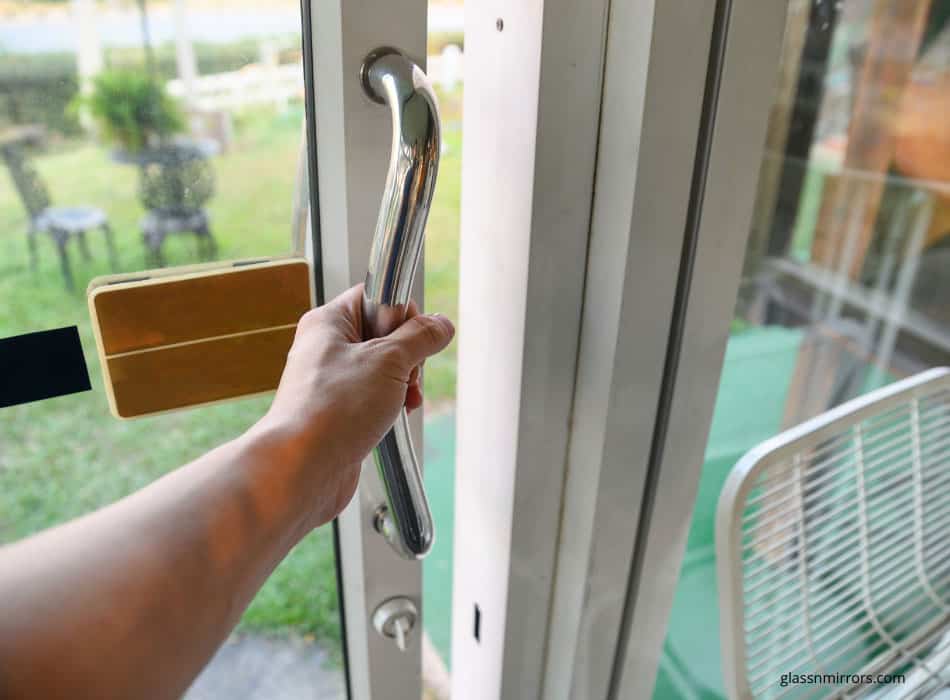So your sliding glass door looks great, has just the right level of durability, and is exactly the way you want it. However, it opens the wrong way. If that’s the case, you don’t want to get rid of the door; you just want to reverse it.
Generally speaking, a sliding glass door can be reversed and will require components like the wheels, stoppers, etc to be removed and reversed. This is also dependant on the type of door it is and who made it.
In this article, you’ll learn how to reverse a sliding glass door, with explanations for each of the following steps.
- Remove the outermost components (including the door) from the frame.
- Detach internal contents that determine the direction (stoppers and door tracks).
- Flip the frame and place the track the way you intend. Attach stoppers in the opposite direction as well.
- Place the door in the stack, so it opens the way you want.

Table of Contents
- 1 How Do You Reverse a Sliding Glass Door?
- 2 Can Sliding Doors Slide Both Ways?
- 3 What Does Reversible Sliding Glass Door Mean?
- 4 Can You Change the Direction of a Sliding Glass Door?
- 5 Conclusion – Can You Reverse a Glass Sliding Door
- 6 Hot Glass vs Cold Glass – What’s The Difference?
- 7 Can Quartz Be Made Into Glass? Guide On Quartz & Glass
- 8 What Is Panda Glass | Ultimate Guide To Panda Glass
How Do You Reverse a Sliding Glass Door?
To reverse a sliding glass door, you’ll need to execute a few steps the strategically flip every aspect of the doors relative to the frame. It is important to understand the door’s operating principles as this will form the knowledge base on which you’ll rely, even if you have to improvise a few steps along the way.
Step 1 – Understand Each Component of the Door
Once you understand the reason your door slides a certain way and what role each component plays, you’ll be able to move different pieces around to make the door slide the other way or even rearrange screens, so the one that slides differently doesn’t bother you as much. While most sliding glass doors are built alike, a few variations exist, which will be covered later in this post.
Generally, sliding glass doors slide only one way, and for a good reason. If every door or screen fit in the frame could move in any direction, the door wouldn’t have the necessary stability to act as a barrier. Ultimately, the majority of a door’s job is to stay shut.
When a glass door slides one way and has fixed components to make sure the reverse doesn’t happen, it is better suited to the dominant hand of the users, doesn’t get slammed in both directions, and makes room for one side of the door to have more control. Usually, it’s the side that faces the room’s interior.
Did you know this hidden fact about 2-way mirrors? Read my article that explains, are 2-way mirrors bad?
With the right screen placement and the one-way sliding screen on the inside, those inside the home can safely lock it and also not get trapped by someone on the outside. More importantly, an intruder cannot easily place the wheels on a putty knife and pop the door out (as you will when reversing the screen).
There’s a sliding track that dictates the movement of the door and wheels on the door that are embedded into the sliding track making sure the door moves as it must.
Moreover, there’s an internal stopper that keeps the sliding door from slamming against the interior of the frame. Each one of these will need to be removed and flipped to make the door slide in reverse.
The video below will help explain these steps and show you how it’s done.
Step 2 – Remove the Door, Sliding Tracks, Stopper, and Screen From the Door Frame
Now that you know what each item in the door assembly does, you’ll need to move forward with the removal of each one of these. Remember, now that you have the knowledge base from the previous step, you’ll not have to worry about multiple wheel tracks or a single track.
After all, you already know that if there are two tracks, you’ll remove both, and if there’s just one, you’ll remove that. The specific number of tracks isn’t important as their function is the same whether a door uses one or two.
Similarly, you don’t need to stop and spend an hour looking for a stopper if your door doesn’t have one. Most doors do, but since its function isn’t crucial to the sliding action, you can ignore it if it isn’t in your door’s assembly.
This step is pretty straightforward, and you just need to make sure of two things: that you remove components in the right order and you leverage the path of least resistance for each one. To adopt these best practices, remove the door components in the order below and follow the corresponding guidelines.
- Remove the outermost screen – Start by removing the outermost screen from the door frame. This is usually the fixed component of the structure but can also be a sliding one. Whichever screen is the closest to the exterior of the frame must be removed first.
- Take out the stoppers – Most doors will have a stopper on the inside that keeps the sliding parts from slamming into the frame. Ignore this step if your door doesn’t have a stopper.
- Remove the door using a putty knife – Gently guiding a door onto an appropriately placed putty knife allows you to pop out the door’s wheeled area from the tracks it is set in.
- Remove the sliding track – The track that guides the door one way and within a specific position can finally be removed, giving you the power to reverse an otherwise irreversible sliding door.
Step 3 – Flip All the Removed Contents
In this step, you’ll put back the contents in the position you want. And this will very likely be a vertical flip. In other words, what was at the top of the frame would go at the bottom. To make things simple, it is advisable to flip the frame and then start installing things the right way (bottom wheels stay at the bottom).
Since the frame is reversed, the wheels are actually going to the top of the frame. Alternatively, you can keep the frame as it is and start installing things upside down, which is more difficult and awkward.
To place back the components in the right (reverse) order, follow these steps.
- Flip the door frame
- Start placing the contents in reverse order starting with the sliding track.
- After the sliding track, put the door back.
- Add stoppers at the end if you removed the stoppers earlier.
A few things to keep in mind are that you will need to readjust the latch and lock mechanism so the door can be locked on the inside as opposed to the outside. Again, this is context-specific and hence isn’t a mandatory step indoor reversal.
Do you know if mirrors reflect heat? Find out by clicking my article.
The above steps cover reversing a sliding glass door that isn’t installed yet. But if you’ve recently moved into a house only to realize that the doors are poorly installed, or they’re easy to remove or lock from the outside, you’ll want to reverse the doors while they’re installed.
Unless you have a very specific kind of glass door where reversible components don’t require flipping the frame, you’ll most likely need to remove the door frame in order to properly reverse the door. Alternatively, you can flip every detachable component without flipping the frame but doing to reverse the door is virtually impractical.
Can Sliding Doors Slide Both Ways?
Sliding doors can go both ways if door frames have two tracks or a place for the door track to be flipped. If the door track isn’t detachable and allows only one-way movement, then the sliding doors can’t slide both ways.
Reversing a sliding door without removing a door frame is easier with sliding doors that go both ways. This is relevant if you’ve not purchased your sliding door or aren’t sure what kind you currently have.
Whether your door can slide both ways is determined entirely by how the number of fixed components in the door frame. These components exist for security and stability. What a door loses in flexibility, it gains in security.
Usually, any sliding doors meant for the outermost door of your home will have more fixed components, including a screen and only one sliding door that travels along a singular path.
Room and hallway doors, on the other hand, can actually be reversible or even slide both ways. The danger of an intruder taking advantage of the exterior placement of a sliding screen is minimal when the doors are inside the house. Sliding doors that go both ways are safe inside the house but are risky outside.
You’ll not need to reverse a sliding door that goes both ways because the door already moves the way you prefer regardless of whether you prefer right sliding or left sliding doors.
It is possible that you actually don’t want the door to move both ways and want to stop movement in one direction. Filling a travel track with caulking will fix an individual door turning it into a stationary screen while the other door moves in one direction.
There are multi-sliding doors where each screen can move in either direction, and they’re rarely ordered without intention. If you’re reading this post, chances are you don’t have multi-sliding doors as you’d know you have them if you specifically asked for them.
The only exception to this is if you’ve just bought a recently flipped house or are renting an apartment with preinstalled doors. In that case, you should be thinking about whether the glass door is reversible since many sliding doors can be irreversible with carved-in sliding tracks.
What Does Reversible Sliding Glass Door Mean?
A reversible sliding glass door is a door that can be reversed with little to no effort. Usually, this is marked by easy to detach wheeled-doors and a reversible wheel track. These doors can also come with latches that can be installed on either side of the door.
Reversible doors are not
considered as safe as doors with
fixed screens.
Reversible doors are not considered as safe as sliding doors with a fixed screen because reversing a door requires detachment. Since it is easier to detach these doors, it is also easier to break in if the said door is installed on the outside. It is therefore advisable to use these doors inside the house.
Such doors can also be expensive, but not because they’re hard to make or require different, more expensive materials. They cost most because they’re a niche product, and manufacturers take a higher risk producing each unit.
So, when you buy a reversible door, you’re not paying for material value, only service value. Still, the mark-up on any single reversible door is smaller than what you’d pay a handyman to reverse a regular door. You also get the benefit of being able to reverse a sliding glass door after installation. That’s something you can’t do with an average sliding door.
Can You Change the Direction of a Sliding Glass Door?
You can change the direction of a sliding door, so it opens to the left or to the right, but only if the door has wheel tracks that can be removed and flipped to accommodate the new direction and door placement.
A sliding glass door that only slides one way would never be shut. A door has to move all the way to one side to open and then the other to be shut. So every functioning door moves back and forth. The sliding direction refers to whether a door goes left to be opened or towards the right.
This might void the warranty of some doors, but you shouldn’t assume a warranty to be void. Keep the slip or sticker if the door has a warranty. Alternatively, you might realize that all this is too much hassle, and you want to replace the door instead.
The effort required to remove the door is also the most laborious part of reversing a door, so it is wiser to reverse the door. You can expect to spend upwards of two hours properly reversing a regular sliding door and less than an hour reversing a reversible sliding door.
Conclusion – Can You Reverse a Glass Sliding Door
You may want to change the direction in which your sliding door opens. This is possible on most doors and you should take close note of the above steps to ensure your sliding glass door can be reversed. The best way to do this is described above. Here’s a recap of the steps.
- Remove the door closest to the track by using a putty knife
- Check for any stoppers and remove them as well
- Detach the embedded door track and flip it to the desired position
- Add stoppers in the opposite spot
- Flip the door and place it the intended way, so it opens in reverse.



